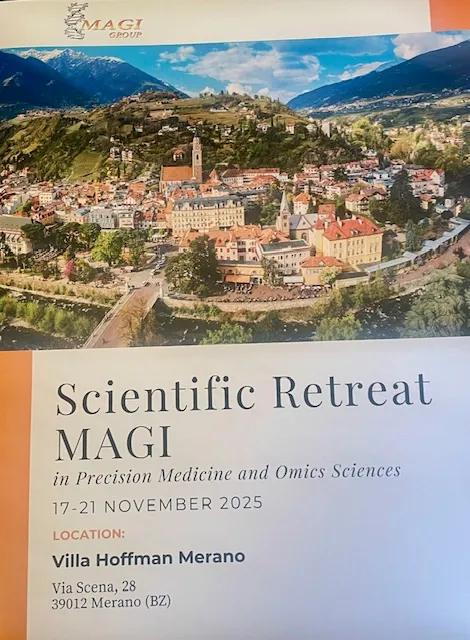General overview of the Villa Hoffmann programme by day and thematic area
From 17 to 21 November 2025, the historic Villa Hoffmann in Merano (Italy) hosted the Scientific Retreat MAGI in Precision Medicine and Omics Sciences, a closed-door working meeting reserved for MAGI researchers and invited colleagues from universities, hospitals and research centres in Italy and abroad. The retreat was conceived not as a public conference, but as an opportunity for focused scientific discussion, exchange of experiences and joint reflection on ongoing projects, with particular reference to rare genetic diseases, multi-omics approaches and data-driven models for precision medicine.
At the heart of the retreat was the idea that genomics, transcriptomics, proteomics, metabolomics and clinical data should be examined together and not in isolation. MAGI, as a research institute specialised in rare diseases and multi-omics technologies, brought to the meeting its internal expertise in molecular diagnostics, biobanking, bioinformatics and statistics. During the five days, computational biologists, clinicians, physicists, biochemists and statisticians discussed shared challenges in variant interpretation, multi-omics integration, modelling of complex phenotypes and the ethical and organisational aspects of data-intensive medicine. The programme combined contributions from MAGI’s internal teams with interventions by external partners, allowing each day to be structured around specific themes and clearly associated with the colleagues most directly involved.

The retreat opened on Monday afternoon with a session devoted to MAGI’s data resources and organisational structure. After a welcome by the MAGI leadership and by Dr Leonardo Don Giovanni, director of the Hoffmann Centre, the Data NEST session provided an overview of diagnostic activities, IT infrastructure and research priorities. Presentations by Matteo Bertelli and colleagues illustrated the development of MAGI’s Lab, MAGI EUREGIO, MAGISNAT and its international branches, the structure of the genetic and omics laboratories, and the progressive consolidation of a multi-centre network. Members of the bioinformatics and IT group, including Jurgen Kaftalli, Alessandro Macchia and other collaborators, described the main pipelines for next-generation sequencing, quality-control procedures, the management of databases and biobanks, and the first results of projects on polygenic risk scores, mutational burden and multi-omics integration. The discussion emphasised the importance of transparent documentation, reproducible workflows and careful governance of genetic and clinical information. The day closed with an open round table in which participants from different sites proposed themes to be revisited during the week and indicated several areas where further internal development and opportunities for collaboration with external groups might be explored.
Tuesday was dedicated to quantitative methods and multi-omics data analysis, with morning and afternoon sessions that brought together statisticians, bioinformaticians and clinicians. In the morning, the session on statistical analysis and predictive modelling examined approaches to the evaluation of high-throughput sequencing data. Presentations by Jurgen Kaftalli, Alessandro Macchia and other members of the statistical modelling group showed how logistic regression, machine-learning classifiers and calibration strategies can be used to support decisions on variant validation, Sanger confirmation and prioritisation of candidate variants in diagnostic workflows. Particular attention was paid to the integration of coverage metrics, quality indicators and clinical annotations, as well as to the challenges of building models that remain interpretable for clinicians.
The afternoon session on data integration and multi-omics involved contributions from colleagues working on metabolomics, lipidomics and proteomics, including Luca, Ekaterina and Kristjana, who presented case studies in which metabolite profiles, lipid signatures and proteomic patterns were combined with genetic data in endocrine disorders, neuropsychiatric conditions and oncology. It was repeatedly underlined that these integrative approaches require careful harmonisation of heterogeneous datasets, explicit documentation of preprocessing steps and rigorous assessment of potential biases. The exchanges during the day highlighted several possibilities for shared datasets and joint evaluation of pipelines across centres.
On Wednesday, the focus shifted to instrumental and physical methods in the life sciences. The morning session, devoted to instrumental and physical models, benefited from the participation of colleagues from the University of Tirana, including Prof. Eglantina Kalluci and theoretical physicists Claudio Peqini and Rudina Osmanaj. Together with MAGI researchers, they discussed how methods from physics and mathematics can contribute to molecular recognition, spectroscopy and the modelling of protein–ligand interactions. The potential of optically detected magnetic resonance, ion-mobility spectrometry and related techniques was examined, with reference to ongoing exploratory work aimed at describing molecular interactions through physical models that complement, rather than replace, established bioinformatics approaches. The discussion stressed the conceptual complexity of these approaches and identified several topics—such as protein modelling and docking simulations—where further joint theoretical and computational work could be useful.

The afternoon session on Wednesday addressed computational cardiology and related clinical applications. Cardiologists, geneticists and data scientists examined variants associated with cardiomyopathies and channelopathies, risk-stratification models for sudden cardiac death, and the integration of imaging, electrocardiographic and genomic data. In this context, collaborations with clinical groups from the University of Brescia were presented, and the contributions of Prof. Pietro Chiurazzi and other experts in medical genetics were discussed in relation to neurodevelopmental and syndromic conditions. Participants underlined the importance of long-term registries, systematic re-interpretation of variants and clear communication of genetic results to patients and families.
Thursday offered a broad exploration of biochemical, multi-omics and computational themes. In the morning, the session on biochemistry and multi-omics integration focused on lipidomics, metabolomics and proteomics in rare diseases and oncology. Presentations by MAGI researchers and external collaborators explored, among other topics, lipid and fatty-acid amide profiles in glioblastoma, endocannabinoid-related metabolites in neurological disorders, and metabolomic signatures of endocrine–metabolic alterations and male infertility. In this area, MAGI maintains a close dialogue with Prof. Aldo Calogero and Dr Rossella Cannarella, whose work on endocrine–metabolic disruptions and andrology provided important clinical context for the discussions.
Ophthalmology emerged as another major theme: colleagues collaborating with clinical groups from the University of Milan, the San Paolo and Sacco Hospitals and the Gemelli Polyclinic in Rome presented data on inherited retinal dystrophies and macular disorders. Proteomic and computational models for these conditions were discussed, emphasising how detailed phenotyping, longitudinal follow-up and multi-omics analysis can contribute to a more nuanced understanding of disease mechanisms and prognosis. In parallel, dermatological perspectives were considered, and MAGI is now establishing a collaboration with dermatologists at the University of Verona to investigate the genetics of Mendelian disorders of keratinisation and inflammatory skin diseases, further extending the spectrum of clinically relevant applications of its multi-omics platforms.
The Thursday afternoon session examined computational genomics, software development and artificial intelligence. Presentations from MAGI’s informatics and data-science teams described the design of internal tools for variant annotation, classification and reporting, and compared their performance with widely used resources such as the Ensembl Variant Effect Predictor (VEP) and VarSome. Work on polygenic risk scores, integration of clinical and omics data, and automatic generation of structured reports was presented by teams including Luca Ferrari, Jurgen Kaftalli, Alessandro Macchia, Sara Feizyab and other colleagues. The importance of transparent versioning, rigorous validation against independent test sets and close collaboration with clinicians was repeatedly stressed. Participants proposed several pilot projects to apply these tools to selected cohorts and to explore how user-friendly interfaces could support both laboratory staff and clinicians in routine practice.
Clinical and translational aspects were present throughout the retreat and were particularly visible in transversal discussions that linked the daily themes. In neurology and neuroimmunology, sessions involving Prof. Paolo Manganotti (University of Trieste) and Dr Lorenzo Lorusso examined rare encephalopathies and complex sleep disorders, such as Kleine–Levin syndrome. These discussions highlighted the value of combining genetic testing, metabolomic profiling and careful clinical observation, while also noting the ethical and psychological implications of working with ultra-rare conditions. In endocrinology and metabolism, the dialogue with Prof. Aldo Calogero and Dr Rossella Cannarella offered examples of how genetic and metabolomic information might be used to characterise endocrine–metabolic dysfunction and male infertility, always with attention to appropriate counselling and realistic expectations for patients.
Vascular anomalies and malformations were the subject of a dedicated discussion, in which Prof. Raul Mattassi and Dr Cavalca reviewed the clinical, radiological and genetic complexity of these conditions. The need for refined classification schemes, secure data sharing and collaborative case discussion was underlined, and the group considered how imaging, histopathology and molecular data might be combined in future observational studies. In ophthalmology, in addition to the sessions dedicated to inherited retinal dystrophies, the retreat hosted broader exchanges on inherited maculopathies and syndromes with ocular involvement, demonstrating how proteomic and computational approaches can complement traditional clinical examination. Opportunities for further joint work with the University of Milan, the San Paolo and Sacco Hospitals, and the Gemelli Polyclinic were repeatedly noted.
The international dimension of MAGI’s activities emerged clearly in contributions from partners working in biotechnology and circular bio-economy, including Prof. Iza Radecka and Dr Fidelin Tuchenbou-Magaia. Their presentations on sustainable biopolymers and microbial production systems were discussed in relation to multi-omics characterisation of strains and to the evaluation of biomaterials with potential medical relevance. These exchanges showed how expertise in materials science, microbiology and industrial biotechnology can intersect with the diagnostic and research activities of a medical genetics institute, creating a fertile ground for future interdisciplinary projects linked to environmental sustainability and human health.

The final day, Friday, was devoted mainly to ophthalmology and clinical data science, consolidating several themes that had emerged earlier in the week. Colleagues presented work on inherited retinal dystrophies, macular degeneration and complex ocular phenotypes, integrating genetic, proteomic and imaging data. Bioinformaticians and clinicians discussed strategies for variant interpretation, prioritisation of candidate genes and design of follow-up studies. A closing plenary session led by Prof. Andrea Bernini summarised the discussions of the previous days, returning to key concepts such as the centrality of rigorous data standards, the need for transparent and reproducible analytical pipelines, and the importance of continuous dialogue between laboratory scientists, clinicians, physicists, biochemists and data specialists. Rather than drawing definitive conclusions, participants identified a series of questions to be examined in greater depth over the coming months and pointed to several promising opportunities for collaboration, training and shared methodological development.
Throughout the week, the organisational support provided by the Hoffmann Centre and its staff played a crucial role. Particular thanks were addressed to Dr Leonardo Don Giovanni for his experience in coordinating scientific retreats, both in Merano and at his Greek venue, the Boutique Hotel Atticos Mare, whose model also inspired some aspects of the Villa Hoffmann programme. The retreat also benefited from the contribution of Sport City Bolzano and Massimo Moretti, the Autonomous Province of Bolzano and the cooperative network Cooper Dolomiti, whose support made it possible to combine intensive scientific work with moments of informal interaction and physical well-being. Social activities and shared meals were repeatedly mentioned by participants as occasions in which scientific discussions could continue in a more relaxed atmosphere and personal connections among colleagues from different institutions could be strengthened.
Taken as a whole, the MAGI Scientific Retreat 2025 at Villa Hoffmann in Merano offered a structured yet informal environment in which precision medicine and omics sciences could be examined in depth from multiple angles. The meeting did not aim to showcase major discoveries or to announce new solutions, but rather to create conditions for open discussion of ongoing projects, critical assessment of methods and careful consideration of future directions. The variety of themes addressed—endocrinology, ophthalmology, neurology, cardiology, vascular anomalies, dermatology, biotechnology, physical modelling, bioinformatics and artificial intelligence—reflected the intrinsically interdisciplinary nature of contemporary medical research. The impressions collected at the end of the retreat suggest that this format, centered on internal dialogue, critical reflection and identification of realistic opportunities for collaboration, represents a promising basis for future scientific meetings and for the gradual consolidation of shared initiatives in precision medicine and omics sciences.




